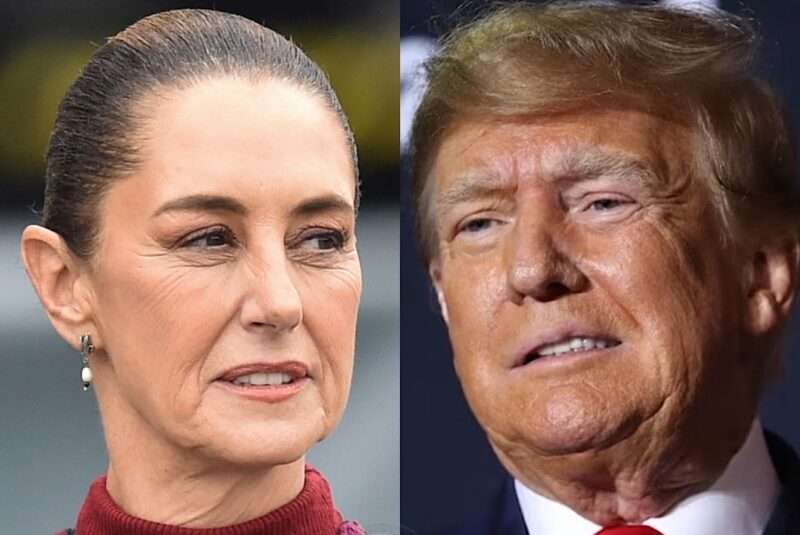
Mexican President Claudia Sheinbaum has asked google to ignore Donald Trump’s request to rename the Gulf of Mexico (Hollywood Unlocked)
by Mick the Ram
Mexican President Claudia Sheinbaum has written a letter to Google asking for the decision to rename the Gulf of Mexico to be reconsidered and the request revoked.
That request, or probably more of demand, of course came from no other than US President Donald Trump, who signed an executive order requiring the body of water – which is bordered by the US, Cuba and Mexico – be renamed the Gulf of America.
The name change appears to be of high priority for Mr Trump, who mentioned it in his inaugural address on 20 January, literally just a matter of minutes after taking the oath of office.
Ms Sheinbaum has criticised Google’s decision, saying they should not respond to “the mandate of a country” to change the name of “an international sea”.
Indeed, her argument that the U.S. cannot legally change the Gulf’s name is absolutely true; that is because the United Nations Convention on the Law of the Sea dictates that an individual country’s sovereign territory only extends up to 12 nautical miles out from the coastline.
Google had said that their “Google Maps” have adopted a long-standing practice of applying name changes when they have been updated in official government sources.
In an ironic retort aimed in Mr Trump’s direction, the Mexican leader suggested that if America gets their way with this change then perhaps maps should also be altered to have the United States identified as América Mexicana, as North America was shown on maps some 400 years ago.
“It’s ours” claims the president
In Donald Trump’s inaugural speech, he repeated a threat he had spoken about in the weeks leading up to him taking office, when he confirmed his intention to rename the Gulf of Mexico and for it to be known moving forward as the Gulf of America.
The ocean basin is an important centre of economic activity, including fishing, maritime transport, and oil and gas production, which probably gives a plausible explanation for the president’s overly enthusiastic interest.
He went as far as to suggest that the new name would be “beautiful” and “appropriate”, and attempted to justify the change by adding: “Because we do most of the work there, and it’s ours.”
No obligation
Theoretically, Mr Trump could relatively easily change the Gulf’s name in official documents within the US, but other countries would not be obliged to follow suit.
There actually is no formal international agreement or protocol for the naming of maritime areas, and no international body has the final word on maritime names, although the International Hydrographic Organization (IHO) seeks to standardise names and resolve disputes.
Generally, the most important policy regarding names is local use and acceptance.
Tongue-in-cheek retaliatory claim
Ms Sheinbaum said: “If a country wants to change the designation of something in the sea, it would only apply up to 12 nautical miles, it cannot apply to the rest, in this case, the Gulf of Mexico. This is what we explained in detail to Google.”
She also seemed to poke fun at Mr Trump’s move by joking that Mexico may demand Google make some additional renaming decisions, telling reporters: “By the way, we are also going to ask for North America to appear on maps as América Mexicana”, in a nod to the fact that as far back as 1607 that was how the mass of land which includes various parts of what is currently the United States, was known and mapped as.
She added: “For us it is still the Gulf of Mexico, and for the entire world it is still the Gulf of Mexico.”
Google looking to be diplomatic
Google said the change will be made “quickly” once the Geographic Names Information System (GNIS) is updated. However, the change in name will only appear for Google Maps users in the US.
They clarified that when official names vary between countries, “Maps” users see their official local name, but everyone in the rest of the world sees both names and “that applies here too”.
Not the first, nor the last
This is certainly not the first time such name discrepancies have caused diplomatic tensions between neighbouring countries.
Iran and Saudi Arabia argue over the name of the Persian Gulf, with the Saudis calling it the Arabian Gulf; and Japan and South Korea have long been embroiled in a row over what to call the waters between the Korean peninsula and the Japanese archipelago. Tokyo calls it the Sea of Japan, whilst the South Koreans refer to it as the East Sea.
The South China Sea is how maps identify the waters between Brunei, China, Malaysia, the Philippines, Taiwan and Vietnam, but it is the West Philippine Sea in the Philippines, the East Sea in Vietnam, and the South Sea in China. A suggested compromise is to call it the Southeast Asia Sea.
Maybe Mr Trump can intervene?






0 Comments